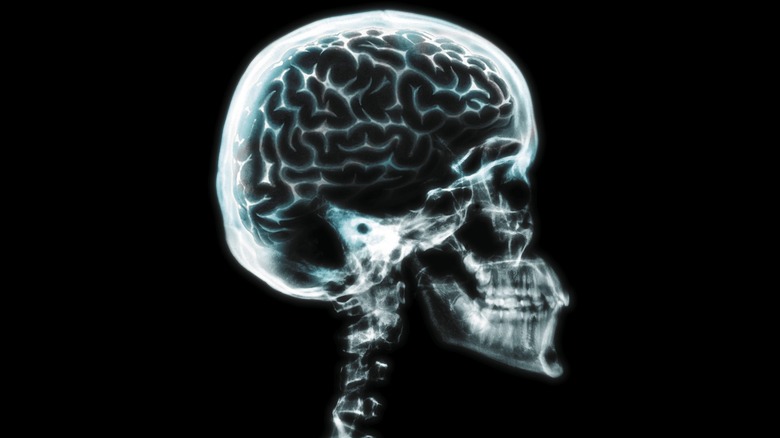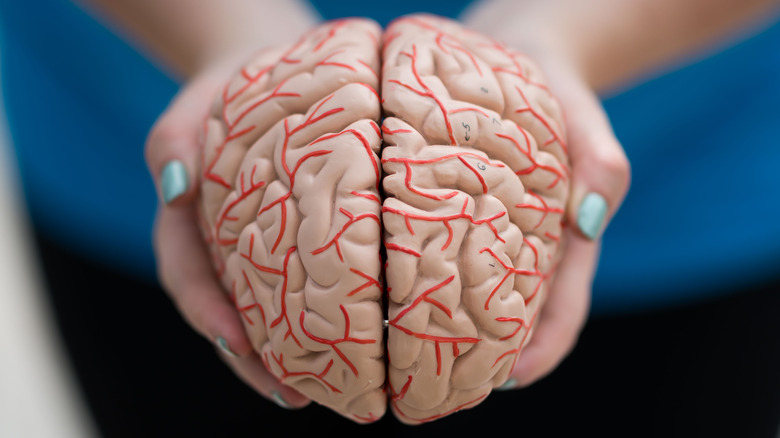The Ethical Dilemma That Comes With Denmark's Psychiatric Brain Collection
Thousands of human brains in the basement: No, that's not a horror movie pitch, but a very real brain collection residing in Denmark, consisting of 9,479 samples of gray matter, as the human brain is sometimes called, per the University of Southern Denmark. According to the CNN International documentary "World's Untold Stories: The Brain Collectors," those brains were gathered between 1945 and 1982 and then stored at the Risskov Psychiatric Hospital in Denmark, first by doctors Erik Stromgren and Larus Einarson, and later by pathologist Knud Aage Lorentzen (via CNN).
The brains in the collection came from thousands of psychiatric patients who had died and were autopsied in that roughly four-decade period, and on the bright side, they now offer an unparalleled opportunity to study a number of mental pathologies that those patients are known to have lived with, such as dementia, schizophrenia, and depression. The brain collection, as SDU notes, also allows for experimental treatments to on samples otherwise untouched by modern medicine. Positive thinking aside, the human minds were collected in such a way that modern scientists interested in using them in their studies are now faced with a troubling ethical dilemma.
The brains are now stored at the University of Southern Denmark in Odense
Per CNN, around 2018, the Danish brain collection was moved from the Risskov Psychiatric Hospital to the University of Southern Denmark in Odense. Knud Aage Lorentzen had retired in 1982 and since then, not much had happened with the assemblage. Stored in rows upon rows of buckets and preserved in formaldehyde, the brains were to be overseen by pathologist Dr. Martin Wirenfeldt Nielsen.
On the formidable task of moving just shy of 10,000 human brains, Wirenfeldt Nielsen, said (via CNN), "The whole collection was just standing there, buckets on top of each other, in the middle of the floor. And that's when I saw it for the first time ... That was like, OK, this is something I've never seen before." Prior to that point, Wirenfeldt Nielsen knew of the cohort of brain samples, but he failed to realize the sheer size and scope of what he was charged with overseeing. The most pressing issue at that point, according to Wirenfeldt Nielsen, was how to efficiently move them.
The brains were collected without the patient's permission
The other dilemma that modern scientists must now contend with is the fact that the psychiatric patients from which the brains were removed did not give their permission. For this reason, in 1991, less than a decade after Knud Aage Lorentzen's retirement, Denmark's national association for psychiatric health — known as SIND — called for the brain collection to be buried, while the Danish Council of Ethics ruled it ethical for the brains to be used for science with only a few restrictions, according to CNN. By 2006, SIND had backtracked on its decision opposing the use of the collection in scientific study, while the Council of Ethics upheld its decision to allow limited experimentation without notifying surviving relatives.
Recalling the debate at that time, Knud Kristensen, one-time director of SIND and a current member of the Danish Council of Ethics, said the harm was already done. "[T]he least we can do to those patients and their relatives is to make sure that the brains are used in research," Kristensen said. Today some Danish survivors of psychiatric patients from the period are attempting to locate their relative's brain. One medical advancement achieved through the collection is a better understanding of familial Danish dementia, and otherwise, the potential remains for further study of a number of other neurodegenerative and psychiatric disorders, according to the Open Patient data Explorative Network.


